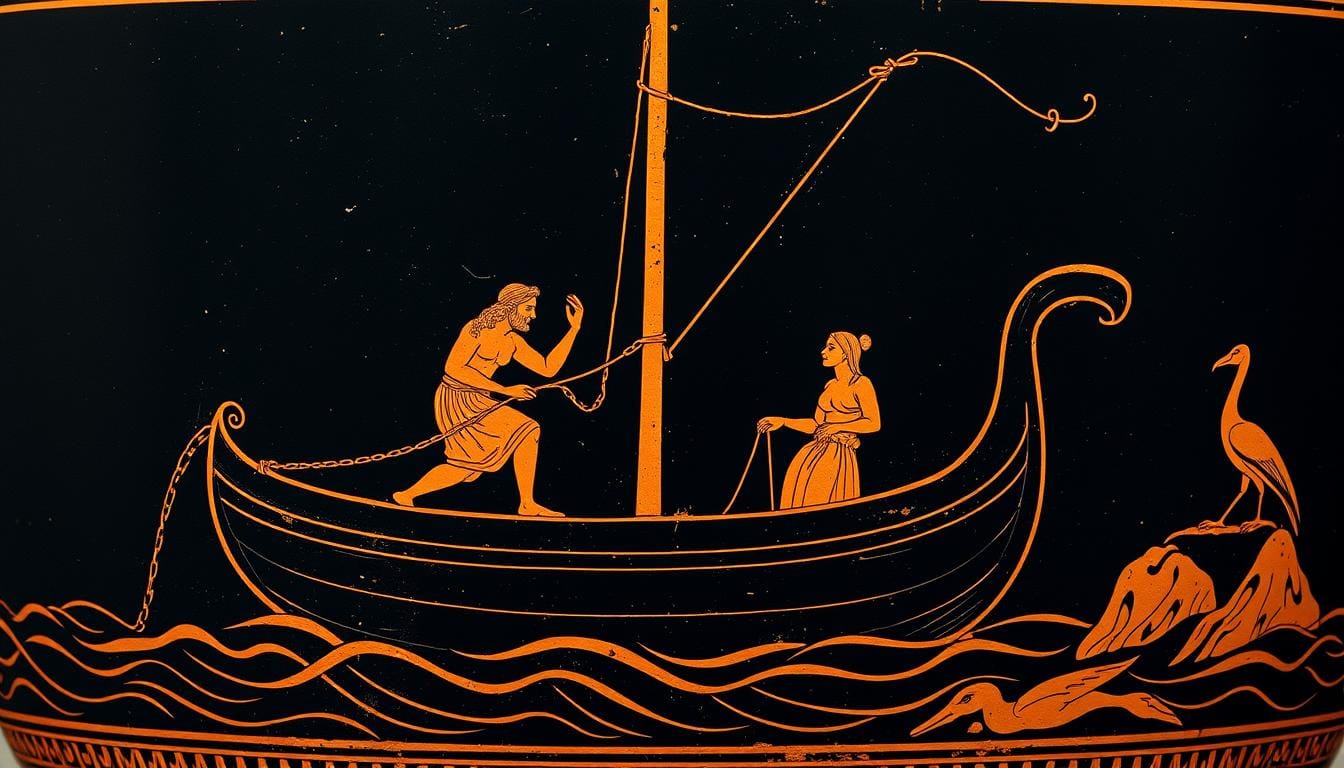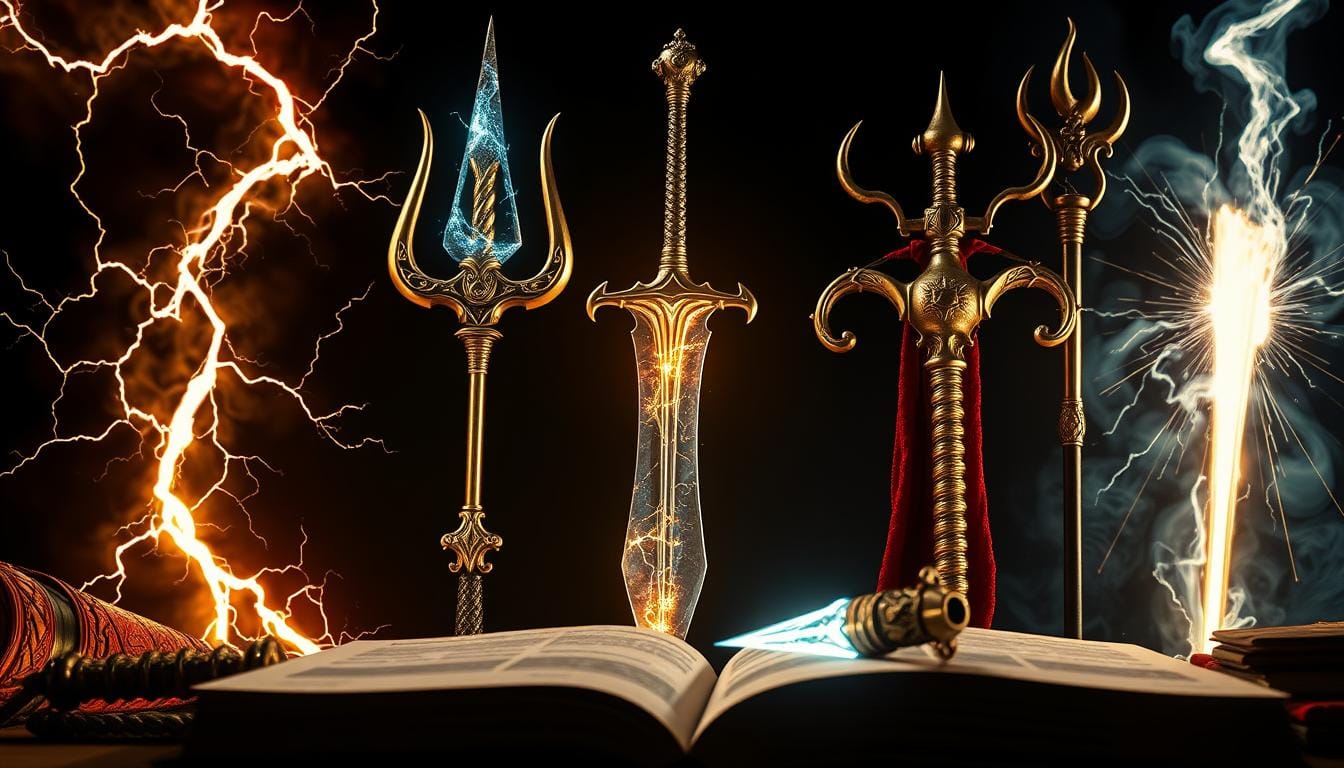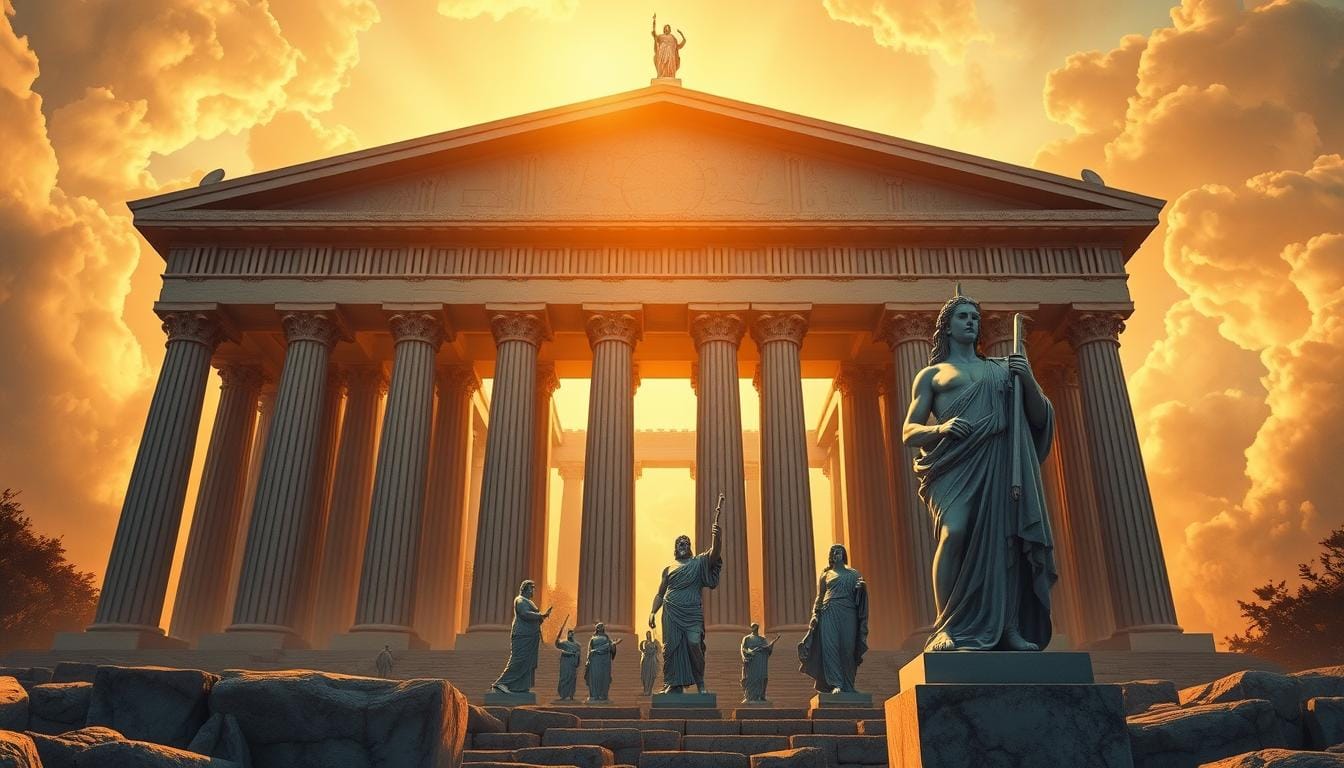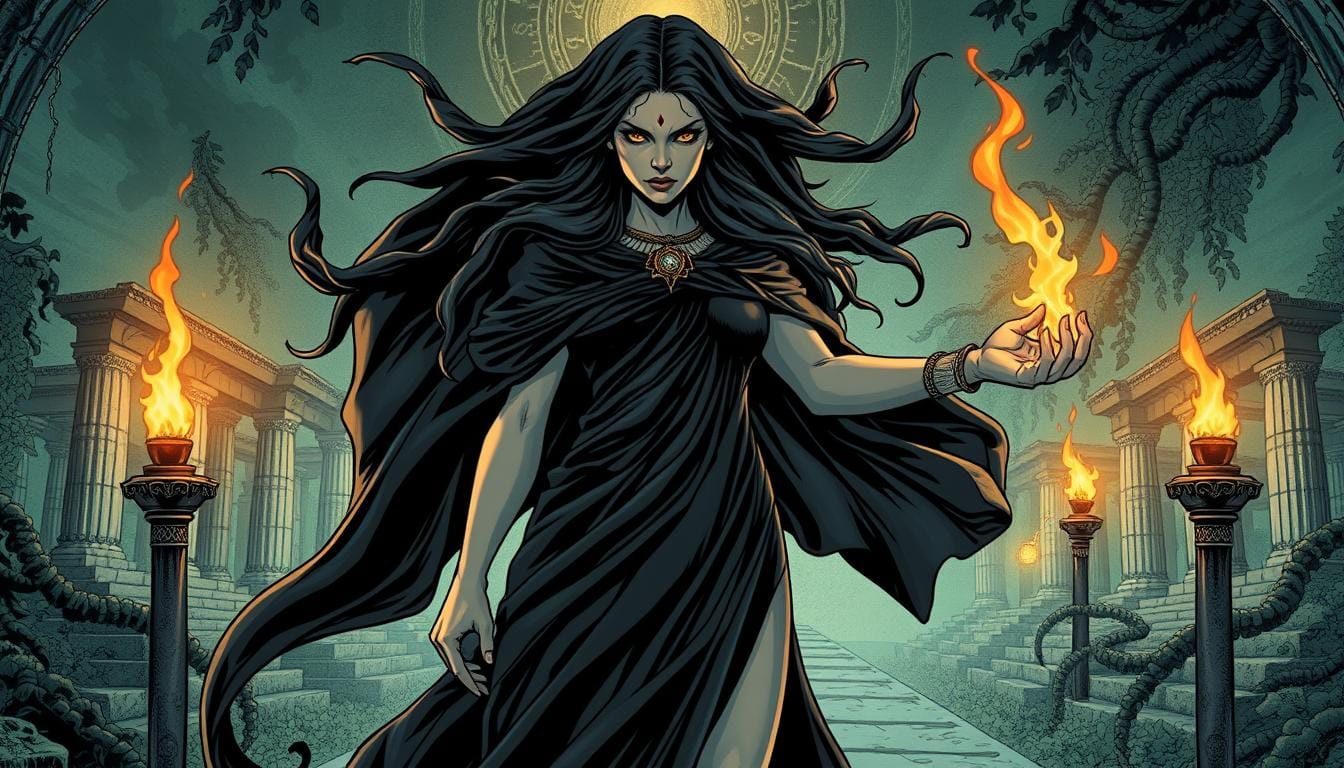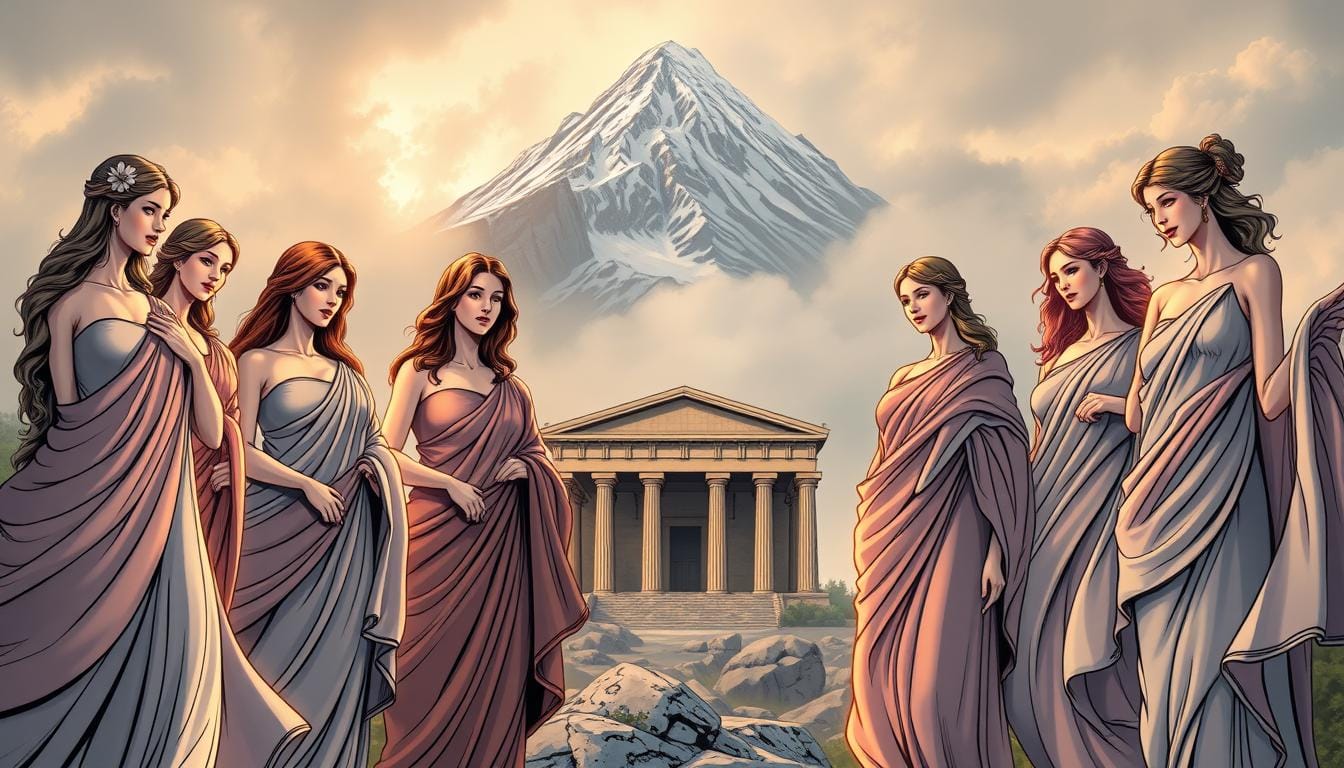At the dawn of existence, before the gods of Olympus ruled the heavens, before humans walked the earth, there was Gaia – the primordial Mother Earth. From her fertile being sprang the foundations of the cosmos, including the mighty Titans who would shape the world to come. As one of the oldest deities in Greek mythology, Gaia represents not just the physical earth beneath our feet, but the very essence of creation itself. Her story weaves through the fabric of ancient Greek cosmogony, connecting the chaotic void of pre-existence to the ordered world of gods and mortals. Join us as we explore the origins, power, and enduring legacy of Gaia, Mother Earth, and witness the birth of the Titans who would forever change the course of mythological history.
Emergence from Chaos: The Birth of Gaia
Artistic representation of Gaia emerging from primordial Chaos
In the beginning, there was only Chaos – a formless void of darkness and confusion. From this primeval emptiness, Gaia (Earth) emerged as one of the first primordial deities, establishing herself as the foundation upon which all life would eventually flourish. Unlike the later Olympian gods who possessed human-like forms and personalities, Gaia initially represented the physical planet itself – solid, nurturing, and eternal.
According to Hesiod’s Theogony, the most comprehensive ancient source on Greek creation myths, Gaia arose after Chaos and before Eros (Love), Tartarus (the Underworld), and Erebus (Darkness). Her name in Ancient Greek (Γαῖα) literally means “land” or “earth,” reflecting her fundamental nature as the ground beneath all existence.
As the personification of Earth, Gaia possessed both consciousness and creative power. She was not merely a passive landscape but an active, generative force capable of bringing forth new life and entities. This creative capacity would prove essential to the formation of the cosmos as the Greeks understood it.
Gaia's First Creations
Once established in existence, Gaia began to shape the world through her creative powers. Her first independent creations demonstrated her ability to manifest cosmic entities without partnership. From her own substance, she produced:
These primordial creations established the fundamental structure of the world. Uranus stretched as a dome above Gaia, creating the heavens. The Ourea provided definition to her surface, while Pontus surrounded her, establishing the boundaries between land and sea. Together, these entities formed the basic cosmological framework within which all subsequent mythological events would unfold.
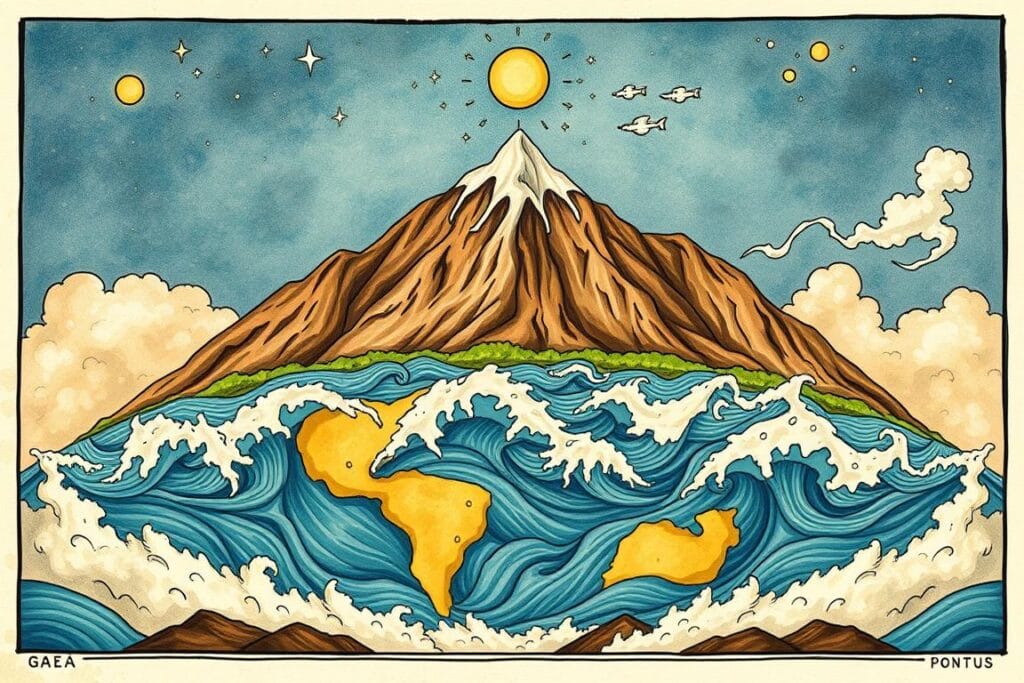
Gaia’s first creations established the fundamental structure of the world
Uranus, as the sky, became Gaia’s first consort – a partnership that would produce the most significant of her offspring and set in motion the dramatic family conflicts that characterize Greek mythology. This union between Earth and Sky represented the first cosmic marriage, a sacred joining of complementary forces that would generate the next generation of divine beings.
The Union of Gaia and Uranus: Birth of the Titans
The cosmic marriage between Gaia (Earth) and Uranus (Sky) represents one of the most productive and consequential relationships in Greek mythology. Their union produced several groups of powerful offspring that would shape the future of the cosmos. As Uranus covered Gaia completely, embracing her from all sides, their intimate connection gave rise to divine children of tremendous power and significance.
The Twelve Titans
Most famous among Gaia and Uranus’s children were the twelve Titans – six males and six females who represented various cosmic forces and natural phenomena. These colossal beings possessed immense strength and would eventually challenge the later Olympian gods for supremacy of the cosmos.
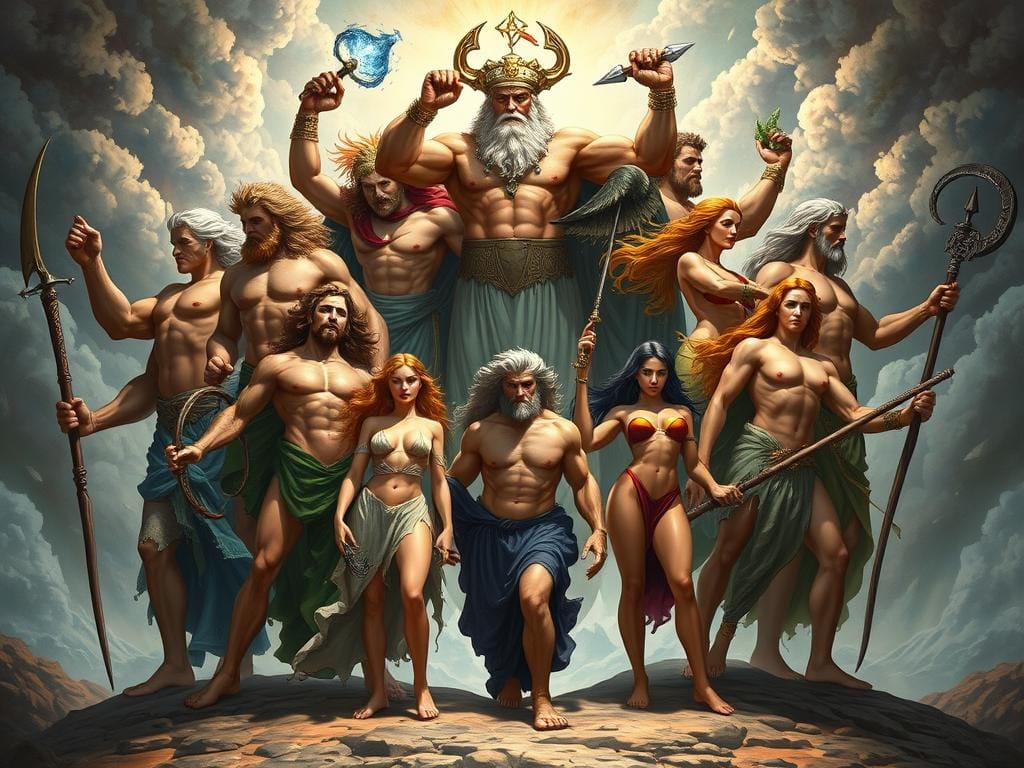
The Twelve Titans: Powerful offspring of Gaia and Uranus
The Male Titans
The Female Titans
These twelve Titans would go on to have children of their own, populating the mythological world with various deities and creatures. Most notably, Cronus and Rhea would become the parents of the first generation of Olympian gods, including Zeus, Poseidon, Hades, Hera, Demeter, and Hestia.
The Cyclopes and Hecatoncheires
Beyond the Titans, Gaia and Uranus produced two other groups of children with distinctive physical characteristics:
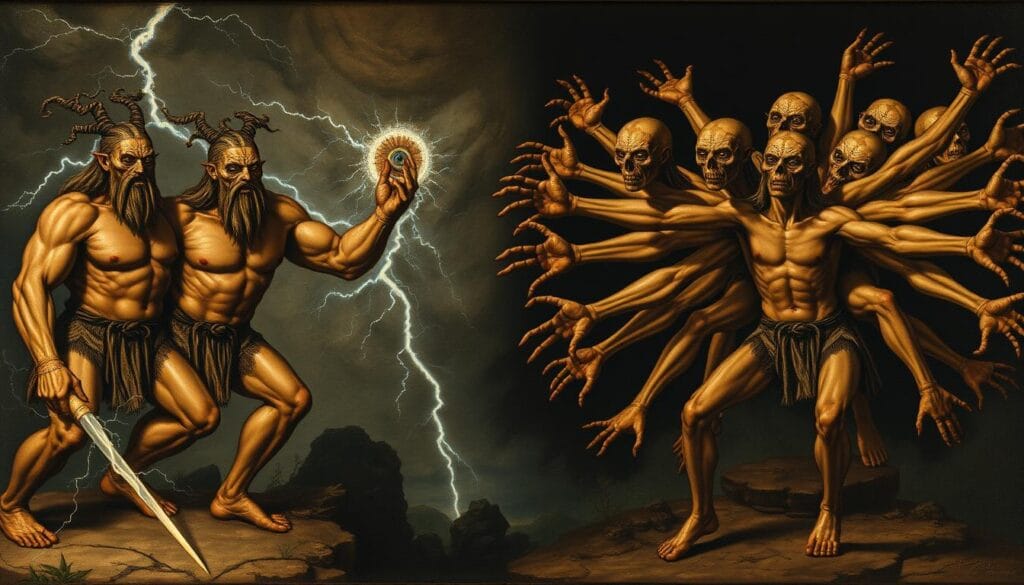
The Cyclopes and Hecatoncheires: The monstrous offspring of Gaia and Uranus
The Cyclopes
The three Cyclopes were giant beings with a single eye in the middle of their foreheads. Unlike the later generations of cyclopes encountered in Homer’s Odyssey, these primordial Cyclopes were divine craftsmen associated with thunder and lightning:
These skilled smiths would later craft Zeus’s thunderbolts, Poseidon’s trident, and Hades’s helmet of invisibility – weapons that would prove crucial in the Olympians’ victory over the Titans.
The Hecatoncheires
Perhaps the most physically imposing of Gaia’s children were the Hecatoncheires (Hundred-Handed Ones), three monstrous giants each possessing one hundred arms and fifty heads:
These formidable beings represented the violent forces of nature, such as hurricanes and earthquakes. Their tremendous strength would later prove invaluable to Zeus during the war against the Titans.
Conflict with Uranus and the Rise of Cronus
The relationship between Gaia and Uranus took a dark turn when Uranus began to display cruelty toward their children. Fearing their power and potential threat to his dominion, Uranus forced the Cyclopes and Hecatoncheires back into Gaia’s womb, refusing to allow them to emerge into the world. This act caused Gaia tremendous physical pain and emotional anguish as she was forced to contain these massive beings within her body.

Gaia’s suffering under Uranus’s cruelty
Gaia's Revenge and the Castration of Uranus
Unable to endure this torment and determined to free her imprisoned children, Gaia devised a plan for revenge. She crafted a great adamantine sickle (or scythe) and gathered her Titan children, asking them to help overthrow their tyrannical father. While most hesitated out of fear, the youngest Titan, Cronus, agreed to assist his mother.
Gaia provided Cronus with the sickle and helped him set an ambush for Uranus. When night fell and Uranus descended to couple with Gaia, Cronus emerged from hiding and, with one decisive stroke, castrated his father. From the blood that fell upon Gaia from this violent act, several new beings emerged:
Meanwhile, Uranus’s severed genitals fell into the sea, creating a white foam from which Aphrodite, goddess of love and beauty, was born. This violent separation of Sky from Earth marked a crucial turning point in Greek cosmology, as it permanently fixed the heavens above and the earth below, creating the cosmic order we recognize today.
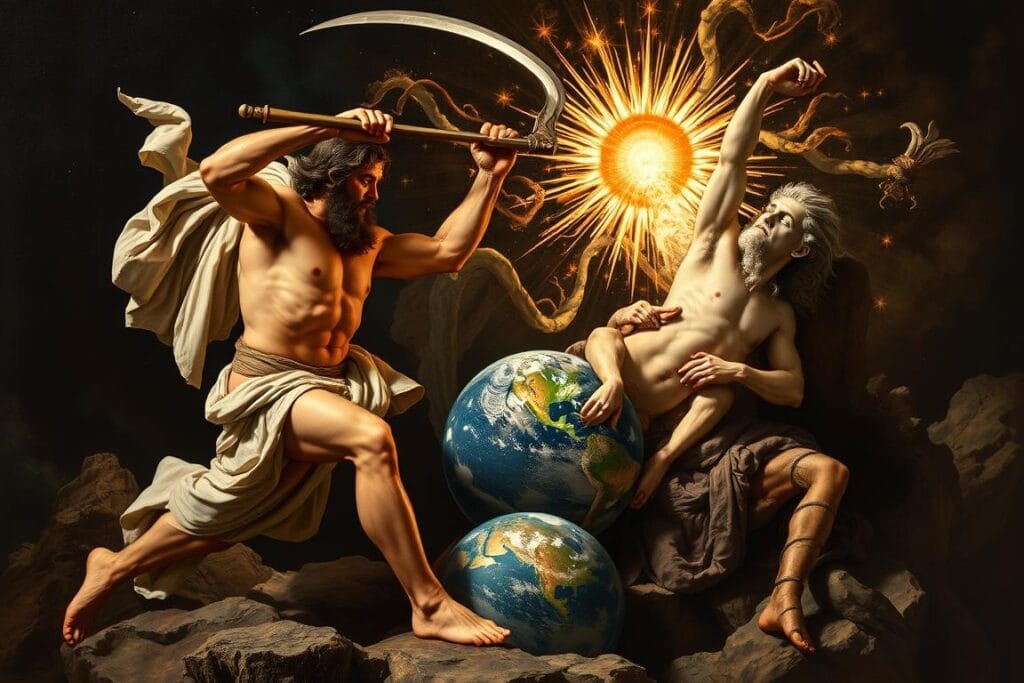
Cronus’s rebellion against his father Uranus, aided by Gaia
The Age of the Titans
With Uranus overthrown, Cronus became the ruler of the cosmos, ushering in what is known as the Age of the Titans or the Golden Age. He released his siblings who had been imprisoned by Uranus but, perhaps fearing a similar fate to his father, kept the Cyclopes and Hecatoncheires confined in Tartarus, the deepest region of the underworld.
Cronus took his sister Rhea as his consort, and together they began to produce the first generation of Olympian gods. However, having learned from Gaia and Uranus that he was destined to be overthrown by his own child, Cronus swallowed each of his children as they were born – Hestia, Demeter, Hera, Hades, and Poseidon.
Delve Deeper into Greek Mythology
Want to discover how the Titans’ rule came to an end? Explore our comprehensive guide to the Titanomachy – the epic ten-year battle between the Titans and the Olympian gods that reshaped the cosmos.
Gaia's Role in the Rise of Zeus
Despite Cronus’s attempts to prevent his downfall by consuming his children, Gaia once again intervened in the cosmic order. When Rhea was pregnant with her sixth child, Zeus, she sought help from her mother Gaia and father Uranus. They devised a plan to save the child and eventually overthrow Cronus, continuing the cycle of succession.

Gaia helping Rhea protect the infant Zeus from Cronus
The Deception of Cronus
Following Gaia’s counsel, Rhea hid in Crete to give birth to Zeus in secret. She then presented Cronus with a stone wrapped in swaddling clothes, which he promptly swallowed, believing it to be his newborn son. Meanwhile, Zeus was raised in hiding, nurtured by nymphs and protected by the Curetes, who would clash their weapons to mask the infant’s cries.
Gaia took a direct role in Zeus’s upbringing, providing guidance and wisdom that would prepare him for his future confrontation with Cronus. This nurturing relationship between Gaia and Zeus demonstrates her continuing influence on cosmic events, even as newer generations of deities emerged.
Zeus's Victory and Gaia's Counsel
When Zeus reached maturity, Gaia provided him with a special potion that, when administered to Cronus, forced him to regurgitate the five siblings he had swallowed. United with his brothers and sisters, Zeus freed the Cyclopes and Hecatoncheires from Tartarus – an act of liberation that earned him powerful allies.
The Cyclopes, grateful for their freedom, gifted Zeus with his iconic thunderbolts. The Hecatoncheires, with their hundred hands, proved invaluable in the ensuing war against the Titans. Throughout this conflict, known as the Titanomachy, Gaia provided crucial advice to Zeus, helping him secure victory and establish the Olympian order.

The Titanomachy: Zeus and the Olympians battle the Titans with Gaia’s guidance
Gaia's Later Conflicts with the Olympians
Despite her crucial role in helping Zeus establish his reign, Gaia’s relationship with the Olympian gods was complex and sometimes antagonistic. As the primordial Mother Earth, she often acted to maintain cosmic balance, which occasionally placed her in opposition to Zeus’s rule when she perceived it as unjust or threatening to her children.
The Gigantomachy: Gaia and the Giants
One of the most significant conflicts between Gaia and the Olympians was the Gigantomachy – the battle between the gods and the Giants (Gigantes). Disturbed by the defeat and harsh punishment of the Titans, Gaia gave birth to the Giants specifically to challenge Zeus’s authority.
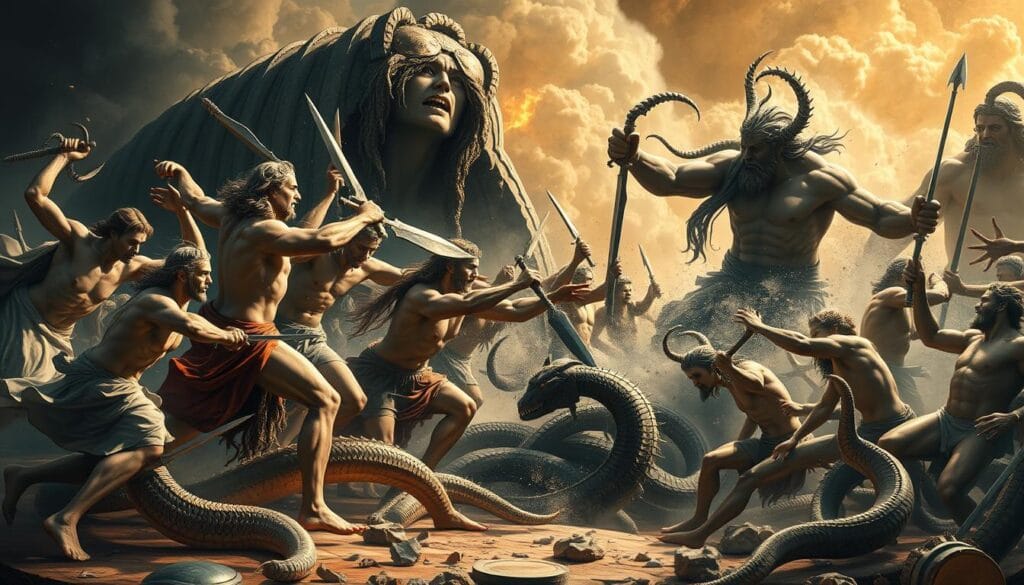
The Gigantomachy: Gaia’s Giant offspring battle the Olympian gods
These Giants were fearsome beings of enormous strength, often depicted with serpentine legs in later art. Led by Porphyrion and Alcyoneus, they launched an assault on Mount Olympus itself. According to prophecy, the Giants could not be killed by gods alone – a mortal’s intervention was required for their defeat.
Learning of this prophecy, Gaia sought a special herb that would protect her Giant children even from mortals. However, Zeus commanded Helios (Sun), Selene (Moon), and Eos (Dawn) to cease shining, plunging the world into darkness. In this darkness, Zeus found and harvested the herb before Gaia could obtain it. He then enlisted the mortal hero Heracles, whose arrows proved decisive in defeating the Giants.
Typhon: Gaia's Final Challenge
In some versions of the myth, after the defeat of the Giants, Gaia made one final attempt to challenge Zeus’s supremacy by giving birth to Typhon – the most terrifying monster in Greek mythology. Fathered by Tartarus, Typhon was a colossal creature with a hundred dragon heads, who breathed fire and made sounds ranging from the howling of dogs to human voices.
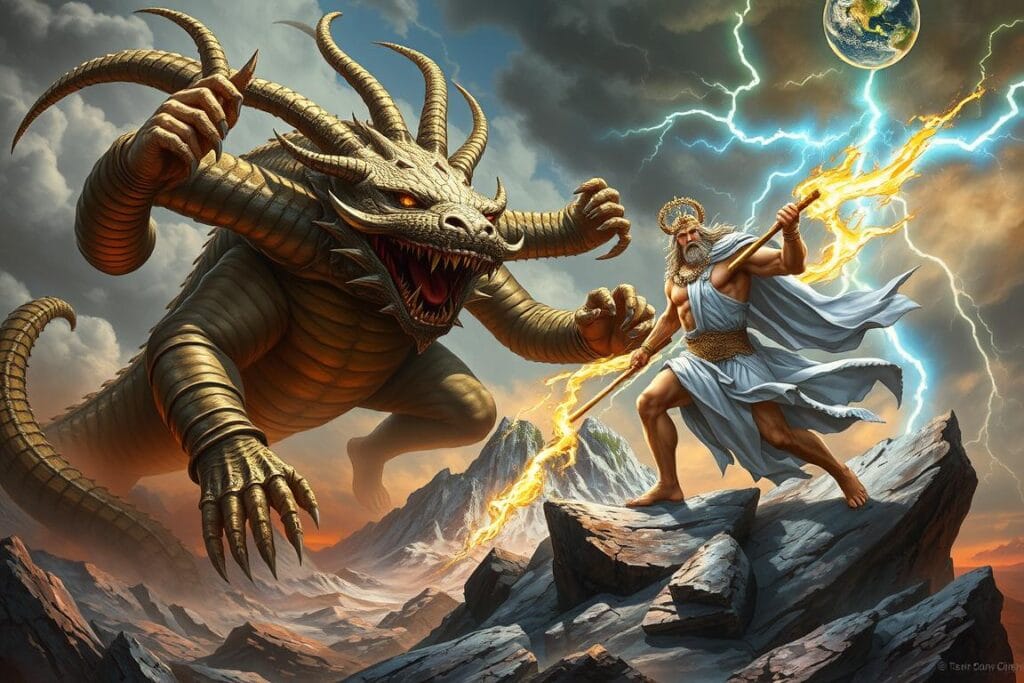
Typhon: Gaia’s most terrifying offspring challenges Zeus’s authority
Zeus engaged Typhon in a cataclysmic battle that shook the cosmos. Though initially driven back, Zeus ultimately prevailed, striking Typhon down with his thunderbolts and imprisoning him beneath Mount Etna in Sicily, where his movements were said to cause earthquakes and volcanic eruptions.
With Typhon’s defeat, Gaia’s direct challenges to Olympian rule came to an end. However, her influence continued through her descendants and through her ongoing role as the physical embodiment of the earth itself.
Gaia's Legacy in Modern Times
The myth of Gaia has transcended its ancient origins to become a powerful symbol in modern culture, science, and spirituality. As humanity has grown increasingly concerned with our relationship to the natural world, Gaia’s representation of Earth as a living, conscious entity has gained new relevance and meaning.
The Gaia Hypothesis
Perhaps the most significant modern application of Gaia’s concept is the Gaia Hypothesis, developed in the 1970s by scientist James Lovelock and later expanded with microbiologist Lynn Margulin. This scientific theory proposes that Earth functions as a self-regulating complex system, maintaining conditions suitable for life through the interaction of living organisms with their inorganic surroundings.
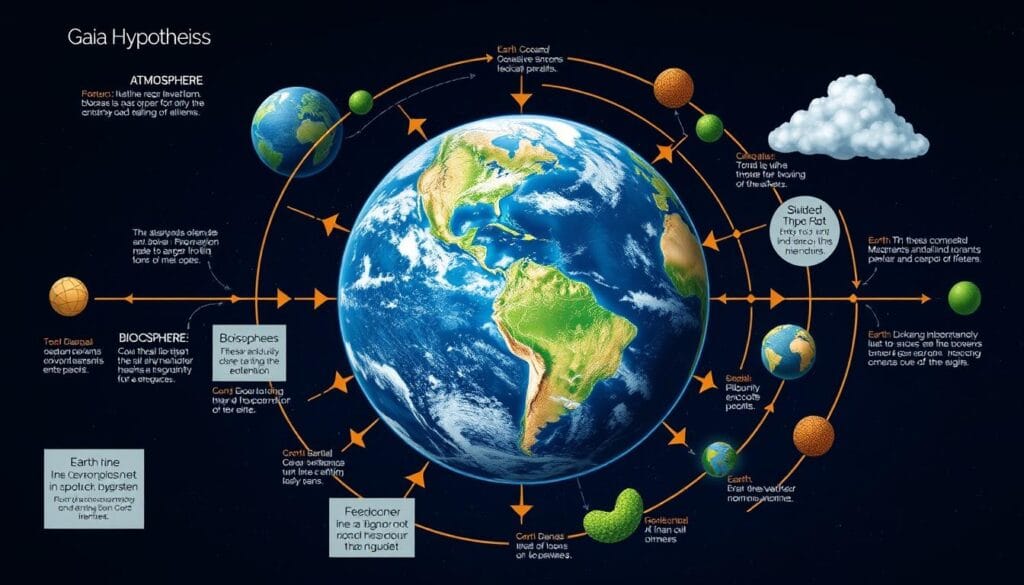
The Gaia Hypothesis: Earth as a self-regulating living system
Just as the mythological Gaia gave birth to and sustained life, the Gaia Hypothesis views our planet as maintaining homeostasis through complex feedback systems involving both biological and geological processes. This perspective has influenced environmental science, systems theory, and our understanding of climate change.
Gaia in Environmental Movements
The concept of Gaia has become central to many environmental philosophies and movements. The image of Earth as a living mother has provided a powerful metaphor for environmental activists seeking to protect the planet from exploitation and destruction. Organizations like the Gaia Foundation work to promote ecological justice and regenerative approaches to agriculture and resource management.
This modern interpretation of Gaia emphasizes our interconnectedness with the natural world and our responsibility as humans to maintain balance within Earth’s systems – themes that resonate with the ancient Greek understanding of Gaia as both nurturing mother and powerful force demanding respect.
Gaia in Contemporary Spirituality
Beyond science and environmentalism, Gaia has experienced a revival in various spiritual traditions, particularly those focused on nature worship and feminine divine energy. Neo-pagan movements, including Wicca and certain forms of goddess spirituality, often incorporate Gaia as a central deity representing the Earth’s life-giving and nurturing aspects.

Contemporary spiritual representation of Gaia as Earth Goddess
These modern spiritual interpretations often blend the ancient Greek understanding of Gaia with concepts from other cultural traditions that venerate the earth as a divine mother. While differing in specifics from the original Greek myths, they maintain the core recognition of Earth as a living entity worthy of reverence and protection.
Gaia in Popular Culture
The figure of Gaia continues to appear throughout contemporary popular culture, from literature and film to video games and art. Her character often represents primal nature, ecological wisdom, or the consequences of environmental destruction. Whether portrayed as a benevolent mother or a force of retribution against those who harm the natural world, Gaia remains a powerful archetype in storytelling.
The enduring appeal of Gaia in modern culture speaks to humanity’s ongoing need to understand our relationship with the planet that sustains us – a relationship that the ancient Greeks explored through their myths of the primordial Mother Earth and her cosmic offspring.
Conclusion: The Timeless Significance of Gaia
From her emergence out of primordial Chaos to her continuing influence in modern environmental thought, Gaia represents one of mythology’s most enduring and evolving concepts. As the personification of Earth and the mother of gods, Titans, and monsters, she embodies the fundamental creative and destructive forces that shape existence.
The myths surrounding Gaia and the birth of the Titans reveal ancient humanity’s attempts to understand cosmic origins and natural processes. These stories of creation, conflict, and succession reflect the Greeks’ observation of the world around them – the stability of earth, the vastness of sky, the cycle of generations, and the sometimes violent forces of nature.
What makes Gaia particularly significant is her dual nature as both nurturing mother and vengeful force. She creates life and sustains it, but also produces monsters and giants to challenge unjust rule. This complexity reflects humanity’s own ambivalent relationship with the natural world – our dependence on Earth’s bounty alongside our vulnerability to its destructive potential.
As we face unprecedented environmental challenges in the modern era, Gaia’s myths offer a timeless reminder of our deep connection to the planet. Whether understood literally as a divine being or metaphorically as the self-regulating systems of our biosphere, Gaia continues to inspire reverence for the Earth and recognition of our place within its greater whole.
The story of Gaia and the birth of the Titans is not merely an ancient tale but a living myth that continues to evolve and speak to each new generation, reminding us of our origins, our responsibilities, and our enduring relationship with the Mother Earth who sustains all life.
Continue Your Journey Through Greek Mythology
Fascinated by the primordial deities and their cosmic struggles? Subscribe to our newsletter for regular updates on Greek mythology, including in-depth explorations of the Olympians, heroes, and the enduring legacy of these ancient stories in our modern world.
